West Virginia is an eastern U.S. state found in the Appalachian Mountains. It is a state rich with history as well as beautiful native flowers, trees, shrubs, and more. If you want to start a native garden or home landscape, there are many great options to choose from.
With this West Virginia native plants list, you can learn more about the plants in this great state and decide which ones are best for your home garden or landscape.
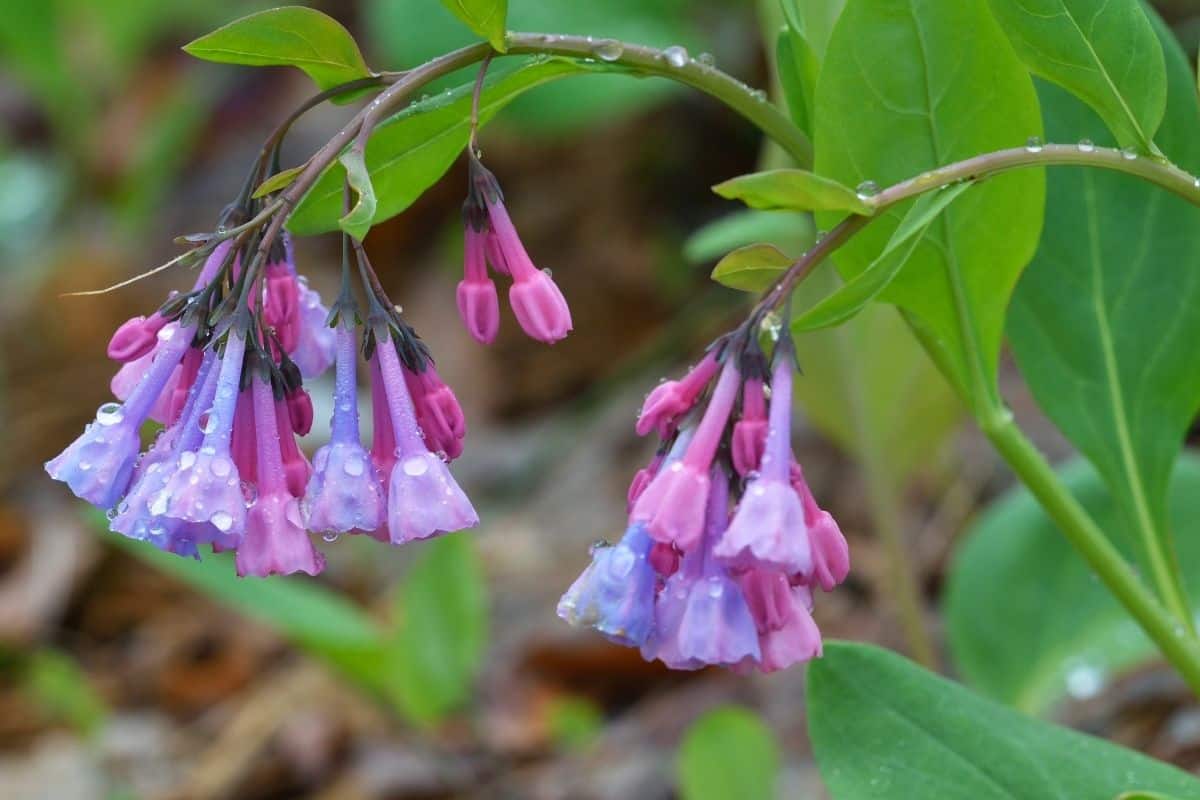
What Are Native Plants?
Before we get to the list, what makes a plant native? The general definition states that a plant is considered native if it occurred naturally in a specific region and was not introduced to the ecosystem by a human.
Native plants are a great choice for your garden or landscape because they are better adapted to the soil conditions, moisture, and weather of the region than non-native plants will be. They need less fertilizer, fewer (if any) pesticides, and use less water. They also help support local wildlife and build the natural ecosystem.
West Virginia Native Plants List
Now let’s take a look at some attractive native plants in WV:
1. Eastern red columbine (Aquilegia canadensis)
Eastern red columbine is part of the buttercup family and is a very unique-looking flower. The showy red and yellow blooms hang down from the tops of the stems and grow in a bell-shaped fashion. They can grow as much as two feet high, and the flowers can be as much as 2 inches long.
The red columbines bloom from February to July, making them a long blooming garden choice. They like dry, sandy, well-drained soil and are very drought tolerant. They prefer part shade to full shade.
They should never be planted in continuous full sun or they will burn.
2. Pink milkweed (Asclepias incarnata)
Pink milkweed is also called swampweed and as the common name implies, it likes swamp-like conditions.
The pink flowers bloom from June to October at the tops of 2 to 4-foot perennial stems. The flowers can vary from light pink to a deeper, dark pink, or rose color.
While this milkweed does have juice or “milk”, it has less of it than other species of milkweeds. They like moist to wet soil and full sun to part shade. They will also attract a lot of butterflies to your garden.
3. Trumpet creeper (Campsis radicans)
Trumpet creeper is a blooming vine also known as trumpet vine, cow vine, or hellvine. It is a high-climbing woody vine that can grow up to 35 feet using aerial rootlets. This means it can be a groundcover or also grow up fences, trellises, trees, and more. It can be trained to grow up and over something in your garden if you want.
The reddish-orange flowers bloom from June to September. It likes full sun, and adapts to various soil types, as long as they are well-drained.
4. New Jersey tea (Ceanothus americanus)
New Jersey tea is also called redroot. It’s part of the buckthorn family and is a low, upright, deciduous shrub that gets about three feet tall.
Small white flowers grow in clusters of about 2 inches wide at the tops of the stems. They bloom in March and April and like dry to moist soil that is well-drained and part shade to full shade.
This plant works well as a ground cover and butterflies are attracted to the flowers.
5. Honey bells (Cephalanthus occidentalis)
Honey bells is a plant with many common names, including common buttonbush, buttonbush, buttonwillow, and honey balls. It’s part of the madder family and is a multi-stemmed shrub that can grow from 6-12 feet tall, on average.
The flowers form at the top of the tall stems in dense, spherical clusters. The white and pink flowers bloom from June to September. This plant likes moist to wet soils, lots of frequent watering, and part to full shade. It is cold tolerant.
6. Blue mistflower (Conoclinium coelestinum)
Blue mistflower is also called blue boneset or wild ageratum. It’s part of the aster family and grows about three feet high usually, although it can be lower.
The disk flowers are bright blue or violet and about ¼ inch long. It doesn’t have ray flowers like some other asters do. It attracts bees and butterflies and is easy to care for. However, it has a tendency to take over and may need to be controlled or trimmed back if it becomes a pest.
7. Goldenwave (Coreopsis tinctoria)
Goldenwave is also known by many common names, including plains coreopsis, golden tickseed, and calliopsis. It’s also part of the aster family and has beautiful yellow ray flowers with touches of red on the inside and red disk flowers in the middle.
It can grow from 1-2 feet tall and the flowers bloom at the tops of the stems.
Coreopsis plants bloom from April to June and like moist, sandy soil and full sun to part shade. They look beautiful in the garden and will attract bees, butterflies, and birds who like to eat the seeds.
8. Whorled coreopsis (Coreopsis verticillata)
Next on our list is another coreopsis from the aster family. Whorled Coreopsis is also called whorled tickseed or threadleaf coreopsis. It grows from 1-2 feet tall and the flowers bloom atop the slender stems.
Blooming from June to July, they like dry, well-drained, acidic soil. They do best in full sun to part shade and will attract birds and butterflies to your garden.
9. Pale purple coneflower (Echinacea pallida)
Pale purple coneflower is from the aster family and grows 2-4 feet tall on stout stems. The large, shower flowers bloom at the tops of the stems.
Usually, they are lavender but sometimes can be white and droop down from a large, cone-shaped center, giving them a very distinct look. They bloom from May to July and like dry to moist soil and full sun.
They are prone to becoming aggressive and do best mixed with grasses but you may need to maintain if they start to take over the garden.
10. Eastern purple coneflower (Echinacea purpurea)
The eastern purple coneflower is an attractive coneflower that does well in native gardens. It is part of the aster family, grows from 2-5 feet tall, with showy purple flowers at the tops of the erect stems.
Purple coneflowers are long-lasting, so they give you nice blooms throughout the season and they are easy to care for. They bloom from April through September and like dry, well-drained soils and full sun to part shade.
They will attract butterflies and hummingbirds to your garden.
11. Swamp sunflower (Helianthus angustifolius)
Swamp sunflower is also called narrowleaf sunflower due to the shape of the leaves. It’s part of the aster family and they resemble small sunflowers.
They grow from 1-3 feet tall, on average, and the flowers are about 2 inches across. They bloom in October and like wet soil and part sun.
They will do best in a bog or pond area, or around water fixtures in your garden and landscape. They’re great for adding a pop of color and for attracting birds to your garden.
12. Shrubby St. John’s wort (Hypericum prolificum)
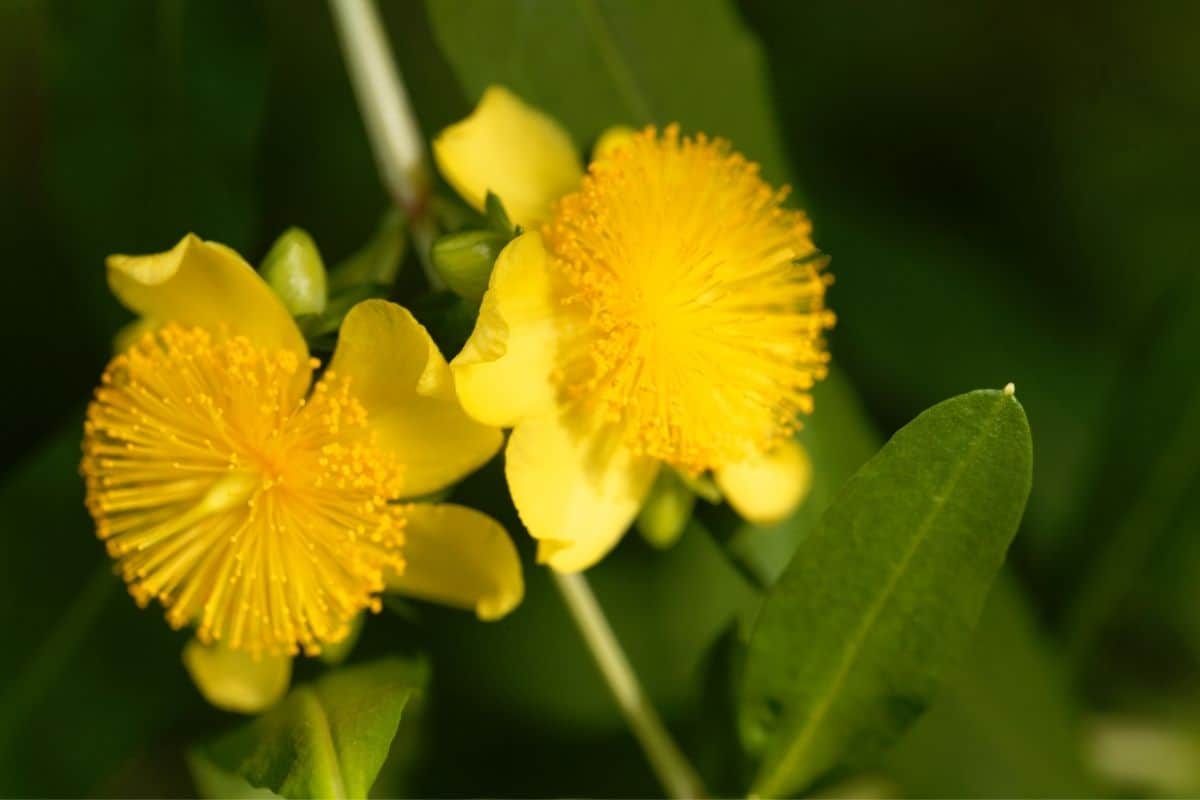
This small shrub grows about 3 feet tall and has large, yellow flowers at the tops of the stems.
It can adapt to various soil conditions and is flood tolerant.
The shrubby John’s wort blooms from June to August and likes dry to moist soil, part shade to full shade, and will attract bees and other pollinators.
13. Calico bush (Kalmia latifolia)
Calico bush is also known as mountain laurel and sometimes as kalmia. This shrub grows from 12-20 feet but can sometimes be taller and trunked. It sometimes grows as a small tree with a short, crooked trunk.
It has large pink to white flower clusters. The showy, bell-shaped flowers bloom from June to July and this plant likes moist soil and part shade.
All parts of this plant are highly toxic. It will attract birds, butterflies, and moths.
14. Scaly blazing star (Liatris squarrosa)
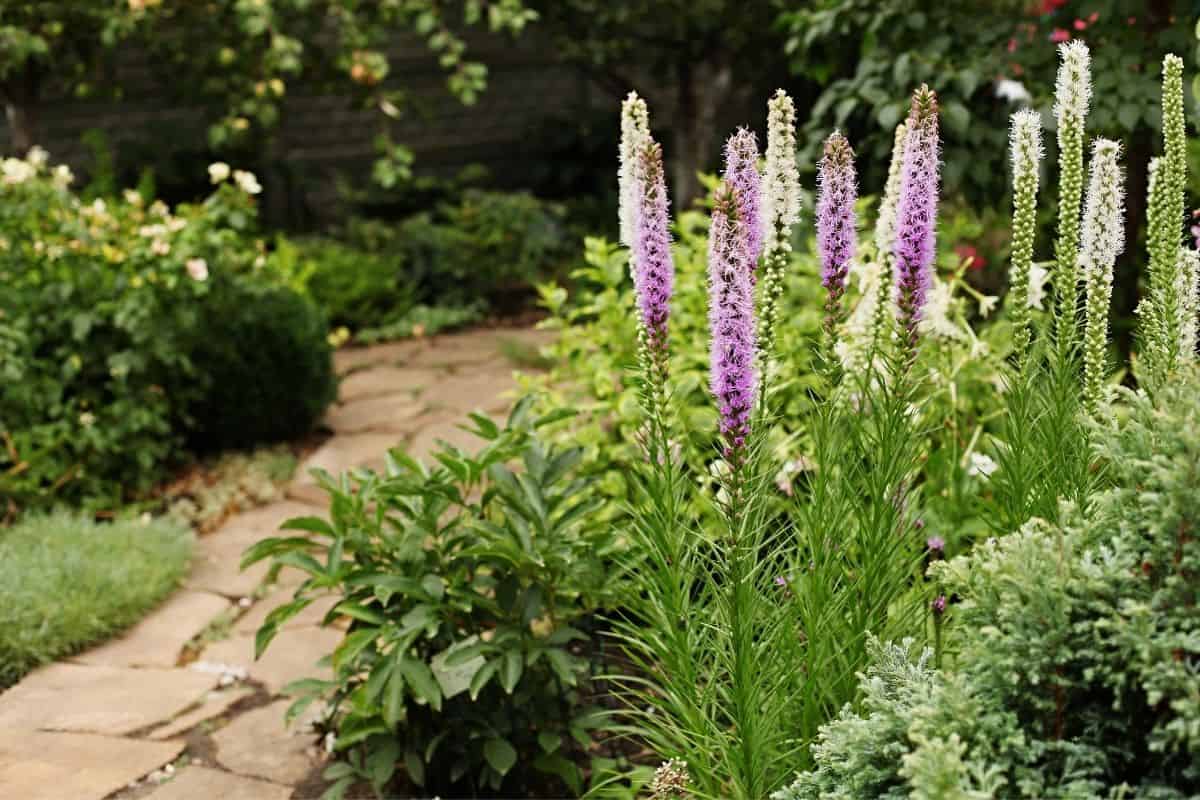
Scaly blazing star is also part of the aster family and is sometimes called scaly gayfeather or scaly Liatris. It grows from 10-24 inches tall and has many leaves.
Tuft-like flower heads grow on a spike along the tops of the stems and are usually red to violet in color. They can appear in shades of purple. They bloom from June to September and like dry, rocky, or sandy soils and full sun.
They are very beneficial to native insects.
15. Cardinal flower (Lobelia cardinalis)
The scarlet red color of the cardinal flower will pop in any garden. It blooms in late summer and can grow from 2 to 6 feet high and likes wet-mesic soil and light shade to part sun.
Cardinal flowers are part of the bellflower family, and the showy red flowers attract birds, butterflies, and bees. The flowers also have a nice aroma.
They bloom from May to October and like moist, wet soil and full sun to part shade. They are both heat tolerant and cold tolerant. This plant is toxic if eaten.
16. Great blue lobelia (Lobelia siphilitica)
Great blue lobelia is also part of the bellfower family. It grows erect stems of 2-3 feet tall with lavender-blue, tubular flowers on the upper portion of the stem.
They bloom from July to October and like moist to wet soil, that is clay, loamy, or sandy. They do not tolerate drought at all and must be kept very moist at all times. If there isn’t enough rain, you will need to water to keep the soil moist. They can tolerate from full sun to full shade.
17. Virginia bluebells (Mertensia virginica)
Virginia bluebells are another native blue flower that looks great in the garden or landscape. They are part of the borage family, and the blue flowers are bell-shaped and grow on the tops of the stems in clusters.
They bloom from March to June and like moist, rich soil and part shade to full shade.
18. Scarlet beebalm (Monarda didyma)
Scarlet beebalm is also known by the names red bergamot and Oswego tea. It’s a beautiful unique-looking plant with stunning, showy flowers that grow in terminal tufts at the tops of the 3-foot stems. It’s part of the mint family and the leaves actually smell like mint when they are crushed.
Dense, rounded, terminal, head-like clusters of the bright red, tubular flowers grow on the tops of the stems. It’s definitely a flower that will stand out in your garden.
The flowers are usually from 2-4 inches, and they bloom from midsummer to fall in their most ideal climates. They like moist to wet, acidic soil and full sun to part shade. Butterflies, hummingbirds, and bees will be attracted to the flowers.
19. Wild blue phlox (Phlox divaricate)
Wild blue phlox is also known as wild sweet William, sweet William, and Louisiana phlox. It can grow into branches of 8-18 inches tall and has loose, flat clusters of fragrant flowers at the tops of the stems.
The flowers are typically lavender, pink, or purple in color. They can be as much as 1 inch across in diameter and bloom from March to May.
This plant likes part shade to full shade and rich, moist, acidic soil. The showy flowers will attract butterflies to your garden.
Now let’s look at some frequently asked questions about native plants in WV.
West Virginia native plants list FAQ
Here are some questions people often have about plants that are native to West Virginia.
What plants grow well in West Virginia?
Many flowers, plants, and vegetables do well in West Virginia. You can never go wrong with a native plant to your area. Some other good choices for vegetable gardens include beets, beans, cabbage, carrots, peas, spinach, and tomatoes.
What is West Virginia’s state flower?
West Virginia’s state flower is the rhododendron. With the recommendation of the Governor and a vote by public school pupils, the Legislature adopted House Joint Resolution 19 on January 29, 1903, naming the Rhododendron the official state flower.
What are some native trees to West Virginia?
West Virginia is home to a lot of native trees. Some to consider are the Douglas-fir and true firs, pine, spruce, larches and tamaracks, and hemlocks. WV forests have some of the oldest and longest-living trees in the world.
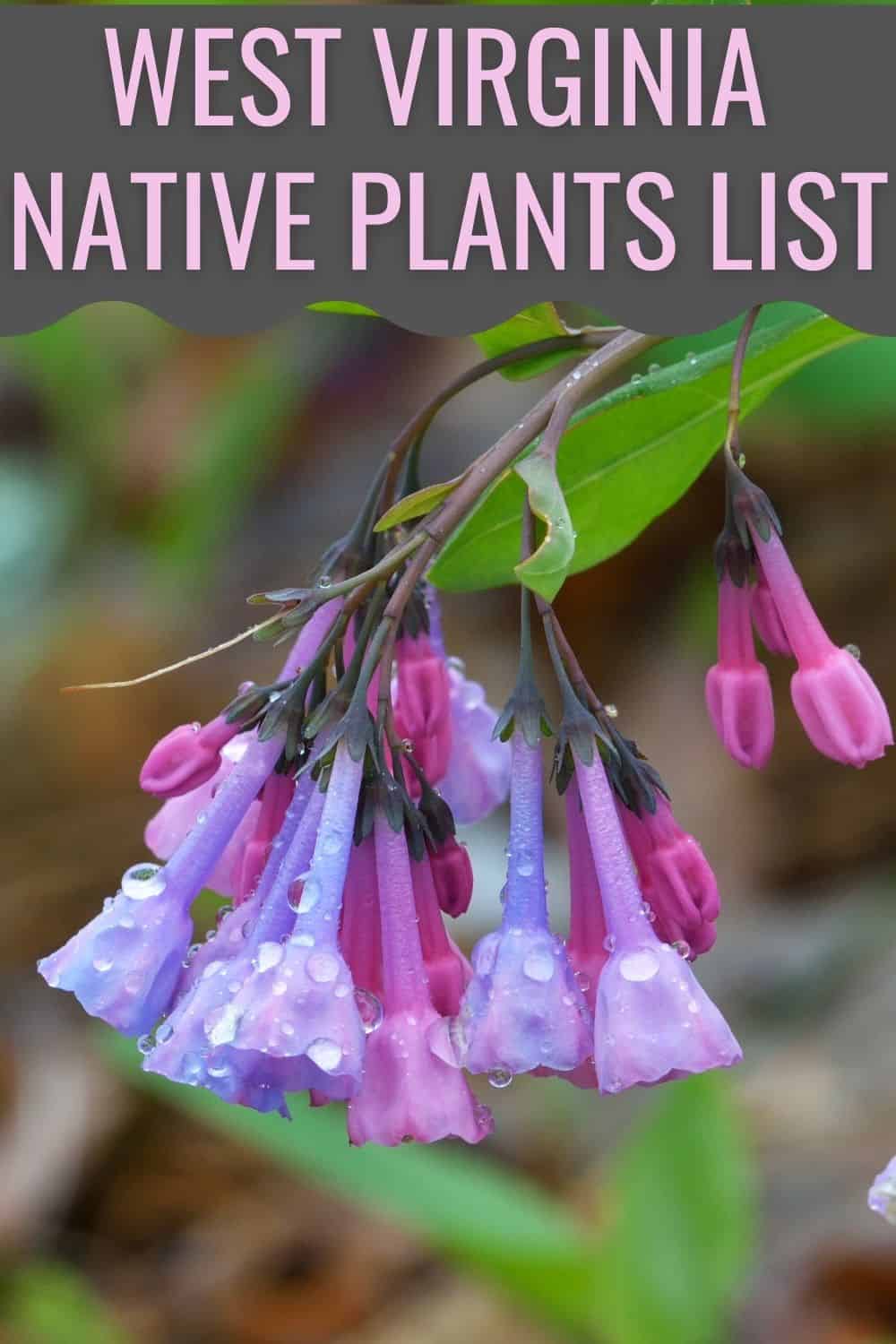

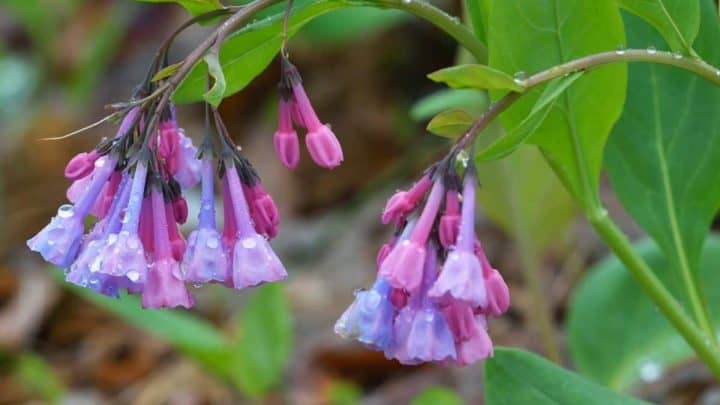


















Allen Kaplan
Thursday 22nd of June 2023
I am attempting to start a meadow near our cabin in Summer County WV. We have deer that loves our new plants as a concern. We live in the middle of a 325 acre farm and I would love to have a meadow on an acre of our farm. Any recommendation as to where to purchase plants or seeds would be greatly appreciated and further publications. Thank you in advance, Allen Kaplan
Adriana
Thursday 22nd of June 2023
Hi Allen, we've been through this as well. So, we contacted our local Natural Resources Conservation Service, and they've been helping us with a plan. We are about to plant a meadow on 2.5 acres in VA. Here's a link to your state's NRCS in WV: https://www.nrcs.usda.gov/conservation-basics/conservation-by-state/west-virginia. Reach to to them and ask for help: we had a wonderful experience with them.